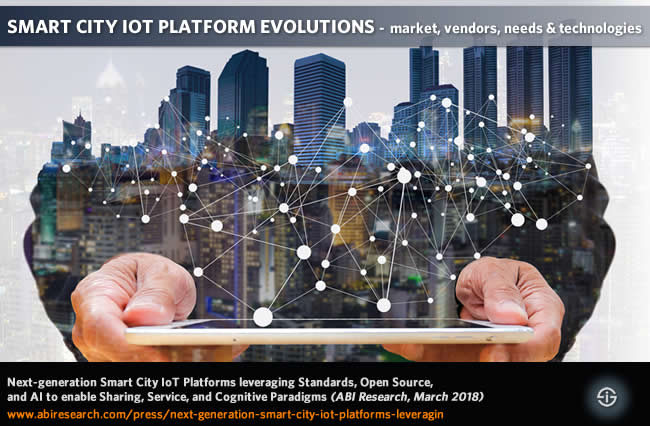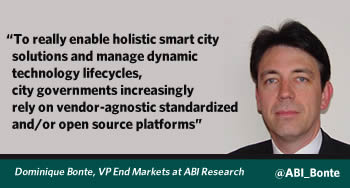With an increasing number of IoT platforms competing for the market in what has been dubbed the IoT platform wars there is an increasing evolution towards vertical specialization, among others with IoT platforms for applications in a context of smart cities.
It isn’t just a matter of a crowded market though. As IoT platforms have become essential parts of the IoT technology and systems stack for several reasons we tackled before and as IoT projects are becoming larger, more integrated, more mature and more driven by specific needs defined by the context and use cases, with a dominant role for Industrial IoT and Industry 4.0 applications, the more vertical approach – that is not new of course – makes sense.
So, one of the verticals which have gained attention from IoT platform providers is that of smart cities (often with specific verticals within the broad reality of smart city ecosystems such as smart buildings, transportation or utilities to name a few).
Ultimately, no single platform will be able to offer all features for all verticals in a smart city environment characterized by a “platform of platforms” approach, with open, interoperable platforms interacting with and complementing each other in a “system of systems” constellation and open ecosystem (ABI Research)
ABI Research looked at the space of ‘next-generation smart city IoT platforms’. The results were announced on March 15, 2018, along with the resulting Smart City Platforms and Standards report.
One of the key takeaways is that city governments seem to increasingly go for vendor-agnostic standardized and/or open source platforms in their efforts to “enable holistic smart city solutions and manage dynamic technology lifecycles”.

Leveraging AI, blockchain and sensor data crowdsourcing in the smart city IoT platform environment
Another evolution in the market is that, while some vendors focus on the width and depth of the functionality they offer, others are increasingly moving in the direction of the inevitable integrations and converging technologies in IoT.
We are indeed talking about IoT and blockchain, IoT and artificial intelligence, IoT, blockchain AND AI (as in the evolutions of i-ERP) and more. The exact same thing is happening in the Industrial IoT platform market where AI engines, cognitive capabilities but also the support of a multi-cloud reality and of the usually more complex use cases with an increasing focus on edge computing (and fog computing), on digital twins, on augmented reality and so forth shape the market and lead to new business models and partner ecosystems.
Another next-gen phenomenon that is popping up in the scope of smart city IoT applications is sensor data crowdsourcing, ABI Research states.
Just as there isn’t one single IoT platform that serves the needs in, for example, the mentioned Industrial IoT applications, there isn’t one in the smart city scope. After all, even though in the end smart cities require a holistic vision, there are differences in cities across the globes and certainly in the various types of smart city applications and mentioned ‘sub-verticals’ within the smart city environment.

Going back to the mentioned ‘convergence’, or rather combination of several groups of technologies classified under broader umbrella terms such as IoT and artificial intelligence, which are about many technologies to essentially leverage data and turn them in insights and decisions, it isn’t surprising that some smart city IoT platform vendors are moving in that direction with blockchain, AI and more entering the mix.
Focusing on the urban economy
However, it’s not just about the use case where such mixes and integrations are key (e.g. pro-active maintenance, semi-autonomous and autonomous decisions or typical use cases in the areas where blockchain and IoT meet).
ABI Research points out that by embracing AI, blockchain and sensor data crowdsourcing a new ‘urban economy’ is enabled “based on sharing, service, and cognitive business models for smart city services like community-based parking, automated surveillance cams, and blockchain-enabled freight tracking”.
As the focus shifted and there are ample other use cases, from environmental applications such as air quality and pollution monitoring, smart healthcare facilities (including outpatient centers), smart buildings and so forth, smart city IoT platforms became the fabric encompassing several technological and data-related aspects such as edge computing and advanced analytics. With the addition of AI, blockchain and sensor data crowdsourcing the possibilities are more in line with the de facto integrated and holistic context of smart cities beyond the project stage.
Leading smart city IoT platform vendors: classification and explanation
Keeping the evolutions in mind whereby open source and/or standardized vendor-agnostic solutions are sought (and emphasizing that standardization organizations such as ETSI prepare smart city data and platform standards), ABI Research classifies the smart city IoT platform providers in several categories.
From that IoT platform vendor perspective the press release mentions:
- The players that are ‘excellent’ from the mentioned functionality viewpoint (across verticals), such as Cisco and Verizon.
- IoT platform providers focusing on the mentioned inclusion and integration with AI, blockchain and sensor data crowdsourcing such as Bosch and, how else could it be, IBM.
- IoT platforms from carriers, network infrastructure suppliers and others which are generic and horizontal, do contain some functionalities in targeting the smart city market but essentially don’t have what the market seeks.
- Smart city IoT platforms that cover one of those verticals within the broader smart city equation. Think about smart buildings, energy efficiency, utilities, public transportation and more. However, ABI Research points out, these are rather more focused on OT (although we would say several are very focused on not just OT and the integration of IT and OT but increasingly on IoT as silos come down in specific of these verticals and even across several of them). Names: Itron, Siemens, Schneider Electric, GE, and Hitachi.
- Next, there is a broad variety of smart city platforms around products and technologies, put into one basket that contains solutions built around cloud technology (you know the names), IT (SAP, NEC, HPE), AI surveillance (NVIDIA), connectivity modules (Telit), cellular connectivity (carriers), and smart lighting (Philips).
From the mentioned perspective of a growing demand for vendor-agnostic standardization and/or open source, ABI mentions InterDigital’s Chordant (flexible pay as you grow with adherence to the oneM2M standard and FIWARE’s open source API approach).
For ABI Cisco, Verizon, Bosch, IBM and Interdigital lead in the way they support urban technology deployments for all the reasons summarized before.
The open source API approach of Chordant revolves around the enablement of applications and services as the focus further moves to gradual deployments, starting from the individual smart city needs and allowing for a degree of readiness for future developments, solutions and growth with urban needs at the center.
InterDigital launched its Chordant Business Smart City Platform, the ‘enhanced combination’ of several InterDigital solutions in October 2017. From the press release: “The Chordant platform gives cities the ability to unlock value from any data source, allowing them to build smart city solutions using a best-of-breed, easily deployable platform. Its oneM2M standards-based approach serves as a means for bringing the legacy and future assets together in a future-proof, standards-compliant solution”. The video below gives an overview.
More in the press release and in the full ABI report, entitled “Smart Cities Platforms and Standards” where the mentioned smart city IoT platforms vendors and many others are looked at and, on top of the role of IoT platforms in smart cities, there is a focus on smart city standards and standardization bodies with, on top of ETSI and FIWARE, BIG IoT, TALQ, W3C and EU EIP-SCC.
Top image: Shutterstock – Copyright: sippakorn – All other images are the property of their respective mentioned owners.

